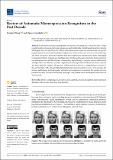Files in this item
Review of automatic microexpression recognition in the past decade
Item metadata
| dc.contributor.author | Zhang, Liangfei | |
| dc.contributor.author | Arandjelović, Ognjen | |
| dc.date.accessioned | 2021-05-04T15:30:08Z | |
| dc.date.available | 2021-05-04T15:30:08Z | |
| dc.date.issued | 2021-05-02 | |
| dc.identifier | 274063249 | |
| dc.identifier | cb4eca70-7329-4344-a638-2e356c1186fe | |
| dc.identifier | 000646865400001 | |
| dc.identifier | 85114345630 | |
| dc.identifier.citation | Zhang , L & Arandjelović , O 2021 , ' Review of automatic microexpression recognition in the past decade ' , Machine Learning and Knowledge Extraction , vol. 3 , no. 2 , pp. 414-434 . https://doi.org/10.3390/make3020021 | en |
| dc.identifier.issn | 2504-4990 | |
| dc.identifier.other | Jisc: 8c4ba34675244311859324bb8baeb037 | |
| dc.identifier.uri | https://hdl.handle.net/10023/23112 | |
| dc.description | L.Z. is funded by the China Scholarship Council—University of St Andrews Scholarships (No.201908060250). | en |
| dc.description.abstract | Facial expressions provide important information concerning one’s emotional state. Unlike regular facial expressions, microexpressions are particular kinds of small quick facial movements, which generally last only 0.05 to 0.2 s. They reflect individuals’ subjective emotions and real psychological states more accurately than regular expressions which can be acted. However, the small range and short duration of facial movements when microexpressions happen make them challenging to recognize both by humans and machines alike. In the past decade, automatic microexpression recognition has attracted the attention of researchers in psychology, computer science, and security, amongst others. In addition, a number of specialized microexpression databases have been collected and made publicly available. The purpose of this article is to provide a comprehensive overview of the current state of the art automatic facial microexpression recognition work. To be specific, the features and learning methods used in automatic microexpression recognition, the existing microexpression data sets, the major outstanding challenges, and possible future development directions are all discussed. | |
| dc.format.extent | 21 | |
| dc.format.extent | 2991626 | |
| dc.language.iso | eng | |
| dc.relation.ispartof | Machine Learning and Knowledge Extraction | en |
| dc.subject | Affective computing | en |
| dc.subject | Microexpression recognition | en |
| dc.subject | Emotion recognition | en |
| dc.subject | Microexpression database | en |
| dc.subject | Video feature extraction | en |
| dc.subject | Deep learning | en |
| dc.subject | BF Psychology | en |
| dc.subject | QA75 Electronic computers. Computer science | en |
| dc.subject | RC0321 Neuroscience. Biological psychiatry. Neuropsychiatry | en |
| dc.subject.lcc | BF | en |
| dc.subject.lcc | QA75 | en |
| dc.subject.lcc | RC0321 | en |
| dc.title | Review of automatic microexpression recognition in the past decade | en |
| dc.type | Journal item | en |
| dc.contributor.institution | University of St Andrews. School of Computer Science | en |
| dc.identifier.doi | 10.3390/make3020021 | |
| dc.description.status | Peer reviewed | en |
This item appears in the following Collection(s)
Items in the St Andrews Research Repository are protected by copyright, with all rights reserved, unless otherwise indicated.

